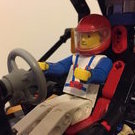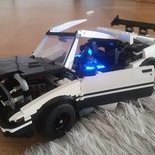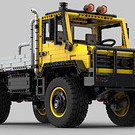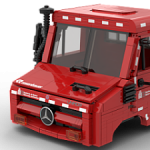-
Content Count
1621 -
Joined
-
Last visited
About gyenesvi
Spam Prevention
-
What is favorite LEGO theme? (we need this info to prevent spam)
Technic
-
Which LEGO set did you recently purchase or build?
42114
Profile Information
-
Gender
Male
-
Interests
Technic MOCs, off-roaders, construction machines, remote controlled vehicles.
Extra
-
Country
Hungary
Recent Profile Visitors
The recent visitors block is disabled and is not being shown to other users.
-

[MOC] RC Jeep Wrangler - 42129 alternate
gyenesvi replied to gyenesvi's topic in LEGO Technic, Mindstorms, Model Team and Scale Modeling
Thanks a lot, glad to hear you see it that way!- 23 replies
-
- off-roader
- 42129
- (and 4 more)
-

42177 Mercedes G500 4X4
gyenesvi replied to SNIPE's topic in LEGO Technic, Mindstorms, Model Team and Scale Modeling
I think at least the looks of it will be pretty close to this one.. -

42176 Porsche GT4 e-Performance
gyenesvi replied to Ngoc Nguyen's topic in LEGO Technic, Mindstorms, Model Team and Scale Modeling
This! This thing is huge and way too specific for one narrow category of products. -

[MOC] Jeep Wrangler 1:13 - Powered Up
gyenesvi replied to gyenesvi's topic in LEGO Technic, Mindstorms, Model Team and Scale Modeling
Thank you guys for all the positive feedback! Thanks for getting back, all good now. Thanks, really honored to hear that :) Thank you very much for the kind words, I really appreciate it! -

General Part Discussion
gyenesvi replied to Polo-Freak's topic in LEGO Technic, Mindstorms, Model Team and Scale Modeling
And what would that contraption be useful for? I guess you can always find a usage that requires a specific part, sure. But I guess probably it would be easier to find more uses for a pinhole with 2L axle. If we call a connection that connects two things in whatever way a basic connection (most existing connectors are like that), then the next logical class off connectors is one that merges two basic connectors into one. And in this case, that would be one unit longer axle or pin on the pinhole.- 4620 replies
-
- Bionicle Technic
- rant!
-
(and 1 more)
Tagged with:
-
gilbertlovetoy started following gyenesvi
-

[MOC] Jeep Wrangler 1:13 - Powered Up
gyenesvi replied to gyenesvi's topic in LEGO Technic, Mindstorms, Model Team and Scale Modeling
Thanks, glad to hear that :) Oh I wanted to respond to this as well, but I forgot. Do you mean the thickness of it, or some other proportions? I do agree that one stud of thickness together with the window frame is a bit too much, but that's what you can do with technic parts if you want to build both the door/window frame and the top separately and in a removable way. But I think that the accidental fact that the windshield arrives to a half stud lower point helps it a bit, kind of rounds it off at the front meeting point, and also looks kind of realistic when the top is off that the rollbar is a half stud lower. Btw, I never saw any model that could solve this problem in a better way, but let me know if anyone knows of any. @Milan, I don't actually see this on the front page. Or is it only scheduled? -

General Part Discussion
gyenesvi replied to Polo-Freak's topic in LEGO Technic, Mindstorms, Model Team and Scale Modeling
I do sometimes (frequently) find myself in need for a pinhole with a 2L axle or a 2L pin. But not so much a 3L axle yet.. So probably better than nothig, but not as good as if things were systematic and progressing in proper steps. I wonder though if these are only templates, and the actual patents cover a family of parts in different sizes, instead of just exactly one size. Patents tend to be as generic as possible. The 3x13 frame does definitely seem useful for smaller models where the 3x19 is too long to fit. The diagonal thing is also interesting, but seems large at first sight.- 4620 replies
-
- Bionicle Technic
- rant!
-
(and 1 more)
Tagged with:
-

Jeep Wrangler with 4L motors, 4 wheels steering and RC electronics
gyenesvi replied to orangetrialtruck's topic in LEGO Technic, Mindstorms, Model Team and Scale Modeling
Nice Jeep, glad to see you could make use of my bodywork design :) Looks good in yellow. I also plan to make an update on it once in the future without part restrictions. That multiple steerig mode feature on the FlySky transmitter is neat, I have that too, a GT5, but haven’t had a chance to test it yet. Maybe when I get to build my first model with custom electronics and GeekServos.. I like how you put the electronics under the hood, great idea! And that video with all the fresh snow looks cool too! -

[MOC] Polaris RZR (42160 alternate)
gyenesvi replied to gyenesvi's topic in LEGO Technic, Mindstorms, Model Team and Scale Modeling
Why do you wish that, what’s wrong with Rebrickable? -

RC Deck - Performance Power Supply With Radio Control
gyenesvi replied to NoEXIST's topic in LEGO Technic, Mindstorms, Model Team and Scale Modeling
That must be a pretty small receiver then! Is that some technological novelty? Would that mean connecting the receiver through a cable, or is it a more direct connection, something like in RCBrick on the bottom? That's kind of an interesting solution, though not sure how many receivers it is compatible with. That sounds good, you mean it would be shorter because of the removed receiver? Interesting to know, I'll test that! -

[MOC] Jeep Wrangler 1:13 - Powered Up
gyenesvi replied to gyenesvi's topic in LEGO Technic, Mindstorms, Model Team and Scale Modeling
Thanks a lot! Thank you guys! These are the hinge parts: https://www.bricklink.com/v2/catalog/catalogitem.page?P=53923#T=S&O={"iconly":0} https://www.bricklink.com/v2/catalog/catalogitem.page?P=57360#T=S&O={"iconly":0} There's also an older version of them with slide slots, which are not so nice I think because you can see the axle color (often red) through it. Thanks, well the original idea is not mine, probably from Madoca. I just saw the opportunity to make it in orange instead of black, which I think does make a big difference in terms of how complete the face is. Thank you! Well actually I was aiming a bit for the more classic look. The modern version is a bit more rounded here and there (for example the face is not straight but bent), which is kind of impossible to recreate in lego. So I'm okay with the retro vibe. Besides, my other option was LBG, which I felt a bit dull. Silver could be nice, but pretty expensive. Black could have been good, but does not exist, though I'm sure I have seen it on some MOCs.. Thanks! Well I am not yet sure if it will survive until the Buwizz camp, because I might need the motors from it to build my entries.. Will see, but I might keep it a bit longer than other models :) -

[MOC] Jeep Wrangler 1:13 - Powered Up
gyenesvi posted a topic in LEGO Technic, Mindstorms, Model Team and Scale Modeling
Hello Eurobrickers, The time has finally come for me to post a model that I have been wanting to build for a long time: RC Jeep Wrangler in 1:13 scale. This is a special one for me because I like Wranglers a lot, and also because the builds and videos of @Madoca 1977 and @rm8 had a major impact on getting me back to Lego Technic. Ever since I saw those videos, I knew I wanted to build my version of the Wrangler. So this is also kind of a tribute to them. Also, there is a third very good Wrangler variant from @ArsMan064, which is actually more accurately scaled than the others, and my version is more like that one in terms of scaling. On the other hand, I wanted my version to be different for a couple reasons. Time has passed since those models, and the lego electronics has changed, so I definitely wanted to build a Powered Up version, which has its own challenges. Also, I wanted to use my own chassis design, and I wanted to change quite a few details on the exterior as well. So this model is the result of all that. To start off, here's an action video: Features all wheel drive with 2L motors, good speed / torque ratio steering by L motor via linkage powered by Technic hub, hidden in the back live axle suspension on both axles, good articulation configurable: easily removable top, doors and rollbar clean exterior and interior openable doors and hood manual winch Design challenges The design of this model has taken a long time and many lessons learned from my previous models. I believe the Wrangler is hard to build in a good scale and in a clean way, mainly because the nose is short and low, so there is little space to work with. Another difficulty is that if one wants a good looking open configuration (which is popular in reality), then the electronics must be hidden well in the chassis, so that reduces the space even further. The original build of Madoca uses a few tricks to mitigate the problem with the nose. On one hand his body is lifted to accommodate the extreme suspension flex, which gives more space under the hood. Furthermore, the nose is one stud longer and the front axle is one stud more to the front than would be accurate when scaled to the wheel size (In this regard, the version of ArsMan is most precise; lower, shorter nose). Furthermore all previous versions route the chassis rail to the front bumper through the bottom of the front face, which prohibits building a completely shaped front face. As the shape of the front face is very characteristic of the Wrangler, I definitely wanted to build it cleanly, but that meant even more space is required for running the chassis rail under it. That left really little space for the front axle, so little that it became impossible to link the steering in front of the axle, so it had to go behind it, which meant that the steering servo had to go further back. And that detail basically defines the whole chassis structure. Chassis structure So it all started off with the design of the front axle, as usual :) I am using a fairly simple one with the steering linkage behind the axle, but that meant that the springs can go either in the center of the axle, or in front. Well, as detailed above, there was not enough space for it in front, so I made a design that has the spring in the center, which required mounting the wheel hub in a bit of unorthodox way, but it works surprisingly well! A dedicated L shaped connector (like this part without one side of the T shape) could be useful here though (and in many other places, I find). Anyways, the axle has attachment points for 4 links plus a panhard rod. Given this front axle, I built a chassis with the steering motor in the middle, protruding a bit into the middle console, and the two drive motors under the seats. The rear suspension is built with the usual positive caster and uses only two links and a panhard rod, with the springs lowered behind it. This was also a crucial point, because of the Technic hub. This large hub can only be positioned above low the rear axle in a way to avoid taking up too much space in the interior, and the springs also need to go around it. Here is the complete chassis, it is quite dense with electronics, they are also structural elements. However, I think it turned out structurally quite clean and light weight, and the axles have quite a good amount of flex and are responsive. Interior I really like the look of Jeeps without the roof and doors, with just a rollbar or even without that. So I wanted to have the interior as clean as possible. Obviously, as the big Technic hub takes the space in the back, that's as good as it can get (and the cables do clutter the looks), but at least the front seats and the area in between and in front remained clean. Luckily, much of the steering motor is covered by the dashboard, and I built the middle console such that it allows the motor to blend in. The drive motors serve as the floor, gears hidden under the seats. I made brick built seats because I wanted to shape them nicely, and also bricks gave me some color options that technic parts would have not allowed. Bodywork There's a simple reason why I built this Jeep is in orange. The key piece to build the front grille in a nice way only exists in black and orange (which is a pity). And as I wanted to have the front built nicely, I had not much choice. Furthermore, I wanted to capture the curved shape of the face, so I had to resort to a brick built solution there. It took a lot of fiddling to let the curvature continue smoothly to the side of the hood, but I am pretty satisfied with the result there. On the top of the hood, Madoca used a few tiles and long panels, which is a neat idea, but I did not like the clutter it took to connect the tiles to the technic pieces, so I used more system pieces for the connection, and turned it into a bulge, which also gives it a bit of texture and opportunity to use a different color, and the border between the brick built and the technic parts became quite smooth I think. The hood hinge point had to be carefully positioned (raised and moved forward a bit) in order to let the hood open without getting blocked (it's not completely smooth though, but good enough). I also made sure the front fenders blend nicely with the tapered nose and the face. Another area I wanted to build differently is the sides / doors. Technic doors are notoriously hard to build nicely (without cluttered look) because of the lack of panels (or even beams) in more sizes, and also it's hard to build the hinge line cleanly (and make the door removable). Here, I experimented with vertical beam stacking instead of horizontal for the sides around the fenders, which turned out quite clean I think. Besides the door itself, the window frame is also a difficult one, and on many models it is unfinished at the front of the door near the mirrors, because it is hard to arrive there at the right position / angle, while also allowing the door to open. That part also took quite some fiddling to get right, but I stumbled on a quite simple solution that even let me fix the mirror in a good position. The point where the side and front windows meet seems tight, but the doors open smoothly without getting blocked. The rollbar is another area I set out to beautify. I wanted to make it slim, tubular looking and uniform, removable, while at the same time properly connected to the chassis and the windshield, and also allowing the top to be connected. Those posable angled connectors came very handy, I think they look better than regular angled connectors, wish they were used more in official sets. Finally, the top follows mainly the shaping of the Madoca version, while I tried to smooth it out as much as possible reducing clutter to the minimum. The top only connects to the rollbar, other than that it only sits on the bodywork, but this way the meeting of the main body and the side of the top / rear window is quite smooth. The rear window can actually be opened if the spare wheel is off. I tried to make the spare wheel foldable, but that made its connection weak, which would have always unfolded during play, so I just simply fixed it. Also, I could not make the tailgate openable, because that's what holds the curved parts on the rear, and the tail lights would have also been in the way, which I definitely wanted to capture nicely. Finally, I added an optional mini winch and a bullbar (which actually uses a flex axle, but could not get that work in Studio, so I used a flexible hose here). Here are some photos of the real build. It's perfect scale for the technic guy :) More renders and photos are available on Bricksafe. Building instructions are available on Rebrickable. Let me know how you like it! Cheers, Viktor PS: a final note about RC control. The development of Pybricks that allows the use of an Xbox controller came recently and I have tested it with this model. I made a program that allows very precise slow speed control (after speed calibration) using the speed servo mode of motors, and also the steering is very smooth; great play experience. Unfortunately at the time of recoding the video I did not have that yet, it would have come handy in some places for precise maneuvers. In the video, I often go much slower than would be possible (it has good amount of torque) just to avoid sudden jumps. I became extra careful after the model accidentally ran off a cliff on the first test day, fell 5 meters and broke into pieces in the middle of a bush.. that hurt. -

RC Deck - Performance Power Supply With Radio Control
gyenesvi replied to NoEXIST's topic in LEGO Technic, Mindstorms, Model Team and Scale Modeling
The receiver looks like this, and is 11 x 25 mm size. How does that compare to the one in RC Deck? One thing about the bind button, I am guessing that binding might need to done more often than one would think, for example if the transmitter is used with other models or one buys two RC decks. I guess then it will always need to be rebound to the one being used. So you might be useful to have that button on the outside, though not sure how that could be done. The split cable is interesting, so then no stacking is needed, but one FP plug still needs to handle the amps of two motors. Maybe it can better do so when they are not stacked though. Thanks for the info on the battery! -

RC Deck - Performance Power Supply With Radio Control
gyenesvi replied to NoEXIST's topic in LEGO Technic, Mindstorms, Model Team and Scale Modeling
Looks nice! Is the receiver on the PCB or is it separate? Any chance that I can swap that out to a FLySky by re-soldering wires? I just bought a small 4-channel FlySky receiver and works nicely with my transmitter. (In general, what's on the PCB and what's separate, if you are okay with sharing such things?) How did you power 4 buggy motors? Did you stack two plugs on one port for that? Didn't that ever melt the plugs for you? Some people reported such things. What's the electronics right where the battery is connected? That seems to take up quite some space, and next to it there seems to be quite a bit of empty space. Do you have a link to the batteries you are using? I mostly find 3s LiPos with larger connectors, like XT 30/60, and often only 2s comes with JST (I guess you are using 3s). -

[HELP] Generic Building Help Topic
gyenesvi replied to Jim's topic in LEGO Technic, Mindstorms, Model Team and Scale Modeling
Quite a bit harder, I'd say more than double; just compared squeezing 2 of the yellow ones vs a big blue one, and still the blue one feels harder to me.





.thumb.jpeg.ee9f4c610e20ae266cdf7b2b392449f6.jpeg)
